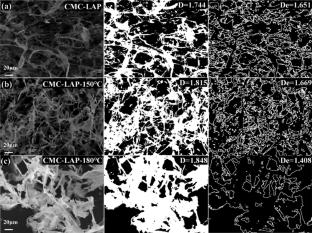Carboxymethylcellulose–laponite nanocomposites as a temperature-resistant rheological modifier
Abstract
Water-soluble polysaccharides generally have the problem of not resistant to high temperature, which limits their application. CMC-LAP nanocomposites were prepared by silanization of sodium carboxymethyl cellulose (CMC) and introduction of nanomaterial laponite (LAP) by APTES. It was found that both the polysiloxane structures formed by APTES and LAP interacted with CMC. Their dual protection of CMC makes the dense network structure still exist in aqueous solution after aging at 150°C. It is very important to maintain the normal rheological properties of drilling fluid. CMC-LAP has great effect as rheological modifier of drilling fluid. The viscosity reduction rate of CMC-LAP drilling fluid after aging at 180°C was only 35%, while that of CMC was 75%. When CMC-LAP is partially degraded at high temperature for a long time in drilling fluid, LAP can play a bridging role in the system through its strong hydrogen bond and electrostatic adsorption. After the system is stable, the network structure will still recover. This network structure enhances the rheological properties of the drilling fluid and improves the ability of the drilling fluid to suspend cuttings and clean the wellbore. We provide a new method to greatly improve the temperature resistance of sodium carboxymethyl cellulose in aqueous solution and maintain normal rheological behavior. The combination of LAP nanomaterials is also a new direction for the study of water-soluble polysaccharides. The materials prepared in this study also show strong application potential in environmentally friendly water-based drilling fluids.
Graphical abstract


 求助内容:
求助内容: 应助结果提醒方式:
应助结果提醒方式:


